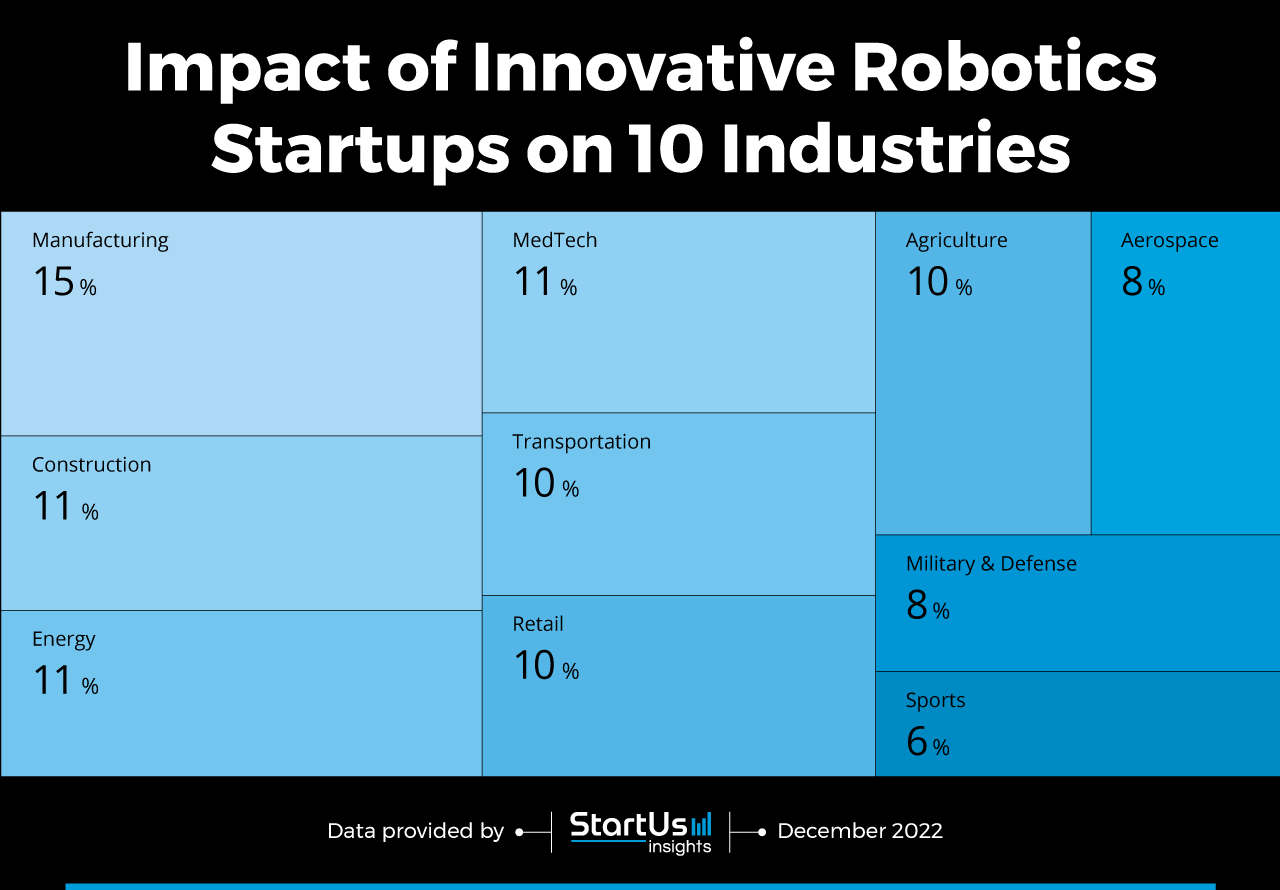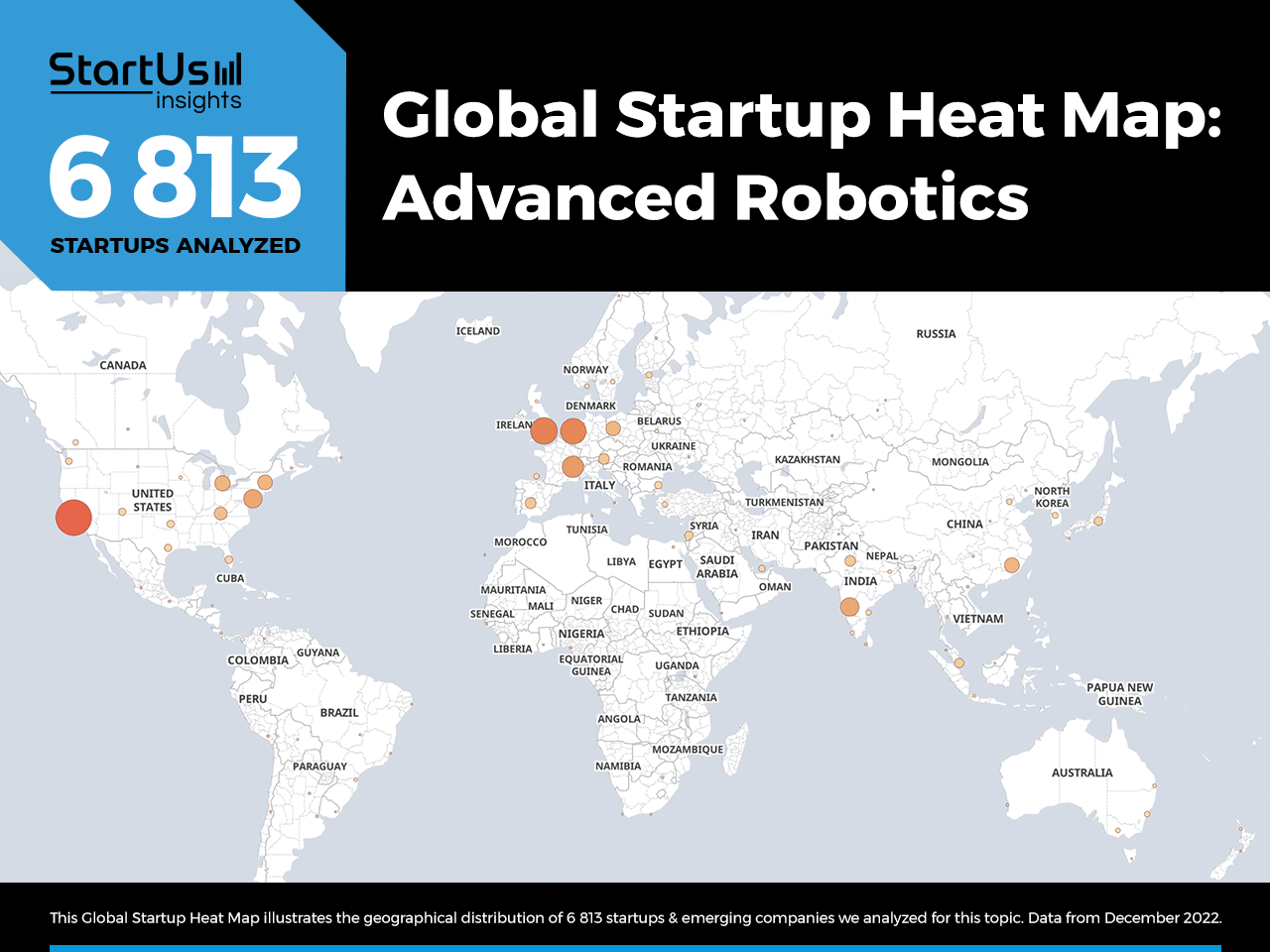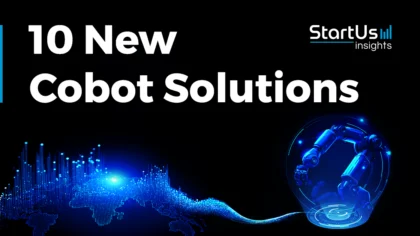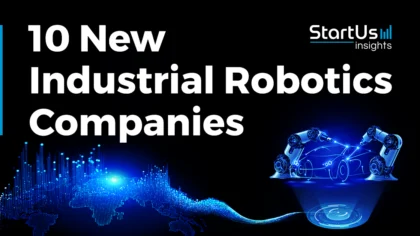Industries are relying on robots to remove workers from hazardous environments and automate repetitive tasks. This improves workplace safety and increases operational throughput. To accelerate robotics applications, startups offer tailored robots for specific use cases that businesses are able to readily integrate into their operations.
This article provides you with innovation insights based on our analysis of 6813 robotics startups and technologies. They assist processes in the manufacturing, construction, aerospace, and retail industries, among others. Read more to explore the impact of robotics on 10 industries and how they advance your business.
Tree Map reveals the Impact of Robotics Applications on 10 Industries
The Tree Map below illustrates the impact of robotics applications on 10 industries in 2023 and 2024. Industrial automation is a critical driving factor for the integration of robotics across industries. As a result, the manufacturing sector is at the forefront of robotization. The construction, energy, and military industries leverage robots to improve personnel safety. On the other hand, the demand for surgical robots is increasing in the healthcare sector.
Robots perform tasks like container loading for transportation companies while the retail sector primarily uses them in manufacturing. Additionally, farmers utilize robotics to mitigate worker scarcity in the industry whereas aerospace companies ensure high precision in their operations using robots. Lastly, the sports sector incorporates robotics to replace trainers and deliver highly competitive practice sessions to athletes.
Global Startup Heat Map covers 6813 Robotics Startups & Scaleups
The Global Startup Heat Map below highlights the global distribution of the 6813 exemplary startups & scaleups that we analyzed for this research. Created through the StartUs Insights Discovery Platform that covers 3 790 000+ startups & scaleups globally, the Heat Map reveals that the US and Western Europe have a high concentration of robotics startups.
Below, you get to meet 10 out of these 6813 promising startups & scaleups as well as the solutions they develop. These robotics applications are hand-picked based on criteria such as founding year, location, funding raised, & more. Depending on your specific needs, your top picks might look entirely different.
Impact of Robotics Applications on 10 Industries
1. Manufacturing
The manufacturing sector deals with highly repetitive tasks most of them in high-risk areas. Allocating workers for such operations negatively impacts production efficiency and safety. On the other hand, robots eliminate both these issues and allow manufacturers to optimize their human resources.
Factories primarily leverage robotics for automating material handling, processing operations, assembly, and inspection. For example, an application of robotics by automotive companies includes welding robots to automate body manufacturing. This improves the reliability and consistency of final products and enables better control over production parameters.
Svaya Robotics makes Collaborative Industrial Robots
Svaya Robotics is an Indian startup that develops collaborative industrial robots. Their high-precision encoders enable repeatability and high accuracy. They also feature built-in sensing powered by computer vision for in-process inspection, polishing, and remote monitoring. Moreover, the startup offers digital twins to better control robotic workflows and enable real-time operational data-driven control. Svaya Robotics’ robots automate assembly, picking, tending, packaging, and welding tasks, among others.
2. Construction
The construction industry is labor-intensive in nature. Integrating robotics into construction processes thus allows project managers to reduce their reliance on workers and optimize resource allocation. Construction companies leverage collaborative robots or cobots where the human workers are not completely removed as well as autonomous robots.
These applications of robotics reduce the burden on workers while ensuring smooth operations. Some robots in the construction sector include brick-laying, welding, and rebar robots, 3D-printing robots for prefabs, and robots for demolition activities. These assets improve construction site safety and efficiency while minimizing operational costs and time to project completion.
Kobots develops Mobile Cutting Robots
Kobots is a Danish startup that creates Amigo, a voice-controlled mobile cutting robot series. They automate cutting through smartphones to free up workers as well as increase productivity and capacity. Amigo robots also include connected vacuum cleaners to create a better working environment for workers. The startup offers three robot variants based on cut size. They are deployable on-site and in workshops and allow construction companies to minimize waste.
3. Energy
The energy sector leverages robots for inspection and maintenance operations. This is due to its large-scale energy assets deployments like solar and wind farms. Moreover, remote energy generation systems, like offshore wind turbines and their sub-sea infrastructures, require continuous monitoring. This puts workers in highly hazardous situations.
To improve inspection efficiency and worker safety, robotics startups offer automated inspection and maintenance robots tailored for the energy sector. For example, some wind farm inspection solutions leverage autonomous drones that use computer vision to analyze asset degradation, while others utilize crawling robots. These solutions allow energy companies to promptly identify faults, like pipeline leaks, to reduce accidents and losses.
ScoutDI provides an Inspection Drone
ScoutDI is a Norwegian startup that offers Scout 137 Drone System, an inspection drone for the energy sector. It includes a drone, ground station, and controller. The startup’s drone utilizes 3D lidar to map surroundings and path planning, thereby ensuring operations in GPS-denied locations. This provides power generation facilities with location-tagged data and improved situational awareness, aiding inspection and maintenance activities.
4. MedTech
Robotics in the healthcare industry fall into three categories – surgical assistance, service, and social robots. Robotic surgery allows physicians to focus more on decision-making and eliminates inaccuracies during surgeries. On the other hand, service robots, mostly autonomous mobile robots (AMRs), aid repetitive tasks inside hospitals and free up time for healthcare professionals.
These tasks include material movement, cleaning, disinfection, and more. Social robots interact with patients to deliver collaborative activities and speed up their recovery. All these robots ultimately improve care delivery for patients. Robots streamline clinical workflows and ensure safer environments for hospitals and other healthcare institutions.
AiM Medical Robotics offers a Neurosurgical Robot
AiM Medical Robotics is a US-based startup that develops a neurosurgical robot. It is a portable magnetic resonance imaging (MRI) compatible robot that improves patient outcomes. This allows surgeons to eliminate errors and reduce procedure times for functional brain disorders, such as Parkinson’s, epilepsy, and cancer.
5. Transportation
The future of transportation and logistics operations relies on robot buses, self-driving cars, automated trains, and among many other autonomous robots. AMRs and loading robots automate material handling inside warehouses and distribution centers, while logistics businesses also leverage packaging robots.
Additionally, autonomous public transport systems are gaining interest among travelers due to their improved safety and reduced delays. Autonomous vehicles also impact the movement of goods, allowing freight forwarders to control their fleets better and reduce delivery delays.
Mob-Energy makes a Charging Robot
Mob-Energy is a French startup that makes Charles, a charging robot. It uses second-life batteries and recharges electric vehicles (EVs) through a connection module. Vehicle owners and drivers are able to access its service through a smartphone app. This allows transportation companies and drivers to eliminate range anxiety and ensure maximum utilization of electric assets.

6. Retail
Retail companies integrate robotics in warehouses and retail stores to automate material handling and cleaning, among other tasks. Robot-driven workflows in Walmart and Amazon stores are examples of such use cases. Retailers also use robots to improve in-store customer experience and inventory tracking.
For instance, some robots interact with customers to direct them to relevant products and increase sales. Deploying robots for inventory movement inside stores also enables workers to interact more with their customers, improving their satisfaction. While the requirements for robotization vary based on specific use cases, retailers are able to increase store efficiency and revenue by integrating robots.
Noyes Technologies delivers an Automated Storage System
Noyes Technologies is a German startup that makes an automated storage system. It is an ultra-dense goods-to-person system that automates material handling in small warehouses. The robot-operated system thus maximizes space utilization and ensures fast fulfillment. This allows eCommerce businesses and retailers to streamline their inventory and reduce delivery times.
7. Agriculture
The agriculture sector lacks the necessary workforce to address the growing food demands. That is why farmers are using agricultural robots to increase their yields and optimize operations. Agricultural robots consist of end effectors, grippers, and manipulators to automate most farming operations.
Growers also utilize drones to analyze their fields and even generate field maps for precision agriculture. Other agricultural robots include harvesting, seeding, spraying, and weeding robots. Further, fruit and vegetable producers utilize picking robots, while indoor farmers leverage integrated robotic systems that automate end-to-end farming operations. These solutions increase farming yield and reduce wastage.
Verdant Robotics advances Robotic Farming
Verdant Robotics is a US-based startup that furthers robotic farming. The startup’s multi-crop robot features a high-speed weed removal and chemical application system, a laser-driven weeding system for non-chemical weeding, and a spray box. It also includes GPS-denied navigation, a plant indexing system, and an in-cab operator interface for real-time alerts.
This allows farmers to enable high-fidelity farming through targeted thinning, protectant, and nutrient delivery, and laser application. Consequently, they are able to increase farming yield and profits.
8. Aerospace
Aerospace manufacturing involves massive structures and components that require machine assistance for movement, installation, and maintenance. Automating such tasks using robots improves production capacity and overall efficiency. The aerospace industry thus integrates robotics in aircraft construction and performing tasks such as drilling and painting.
Other applications of aerospace robotics include airplane washing and propeller blade polishing. The rigid manufacturing capability of robotization enables high-precision components with tight tolerances and repeatability, which is critical for aerospace components. Aerospace businesses also utilize robotics to inspect aircraft elements and promptly identify deterioration or quality issues.
Aort develops a Drilling Robot
Aort is a Turkish startup that makes a drilling robot for aerospace manufacturing. The startup develops custom robots for surface treatment, loading, unloading, palletizing, and more. Through this, Aort is able to offer robots based on specific requirements from its clients. This accelerates robotization for aerospace manufacturers and improves production throughput.
9. Military & Defense
The use of loitering munitions or suicide drones in the Russo-Ukrainian war is an example of military robot use cases. Militaries leverage robots for reconnaissance, search, rescue, and offensive missions. They replace soldiers on the battlefields and automate various tasks such as explosive neutralization and sniper detection.
While militaries primarily utilize teleoperated robots, advances in autonomous navigation and artificial intelligence (AI) enable automated high-precision military robots. Consequently, mission control units are able to mitigate fatigue and stress in human soldiers and eliminate irrational decisions. This, in turn, allows authorities and governments to ensure civilian and military personnel safety.
LeoTronics offers Mine Clearance Robots
LeoTronics is a Slovakian startup that makes TrackReitar CleanField series of mine clearance robots. They combine night vision, video cameras, other sensors, and advanced robotics to demine anti-personnel mines. The startup’s robots also neutralize tripwire mines and explosive remnants of war. This allows militaries to increase mine clearance speeds and ensure personnel safety on battlefields.
10. Sports
The sports industry utilizes robots to augment training sessions for athletes and players. This includes sparring robots that move away from boxers during practice sessions and golf teaching robots. As a result, robots in sports ensure that all players and athletes receive tailored partners, ensuring continuous performance improvement.
Moreover, these robots offer critical insights into player performance to better plan training sessions. Sports venues also leverage robotics to improve audience engagement. Stadium logistics is another segment that robotics improve through automated order fulfillment and stock management, improving sales. Lastly, robots provide decision support for referees and linesmen.
Trajekt Sports makes a Pitching Robot
Trajekt Sports is a Canadian startup that provides Trajekt Arc, a pitching robot. It imparts gyro spin on the ball and accurately controls ball orientation, enabling more dynamic trajectories and pitch movement. It also visualizes pitcher delivery to familiarize batters with opponent pitchers and improve timing. This allows baseball clubs to offer a wide range of pitching practice to batters and ensure performance improvement.
Discover All Robotics Applications, Technologies & Startups
The interest in robotics in the industrial and commercial segments is accelerating. As a result, more robotic solutions will be integrated into production lines and industrial operations as well as in households and consumer-facing businesses. However, the cost-effectiveness of such robots is a critical factor in this transition. That is why robotics applications offers novel and on-demand solutions to mitigate capital expenses. Get in touch to identify specific robotics startups & solutions that advance your business!








